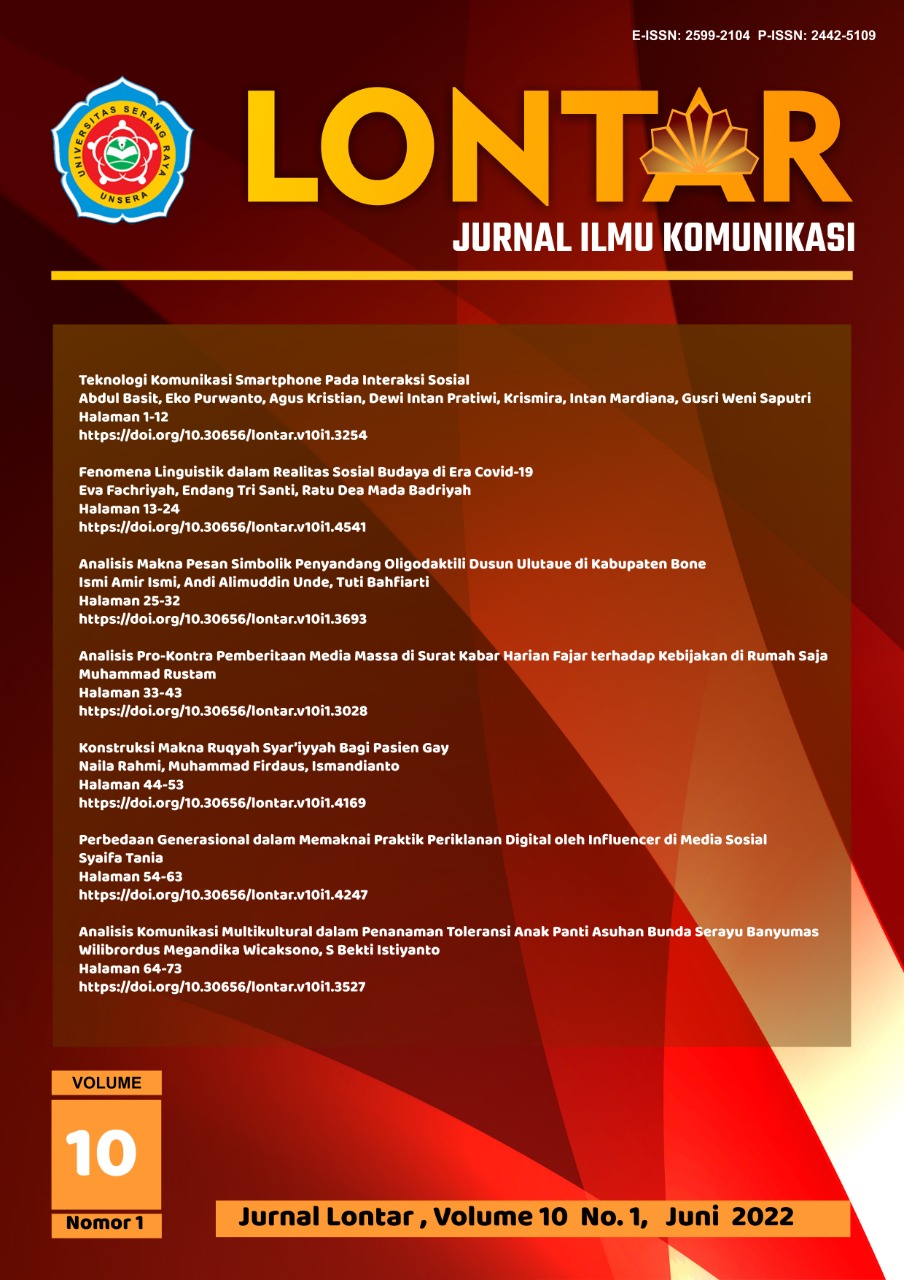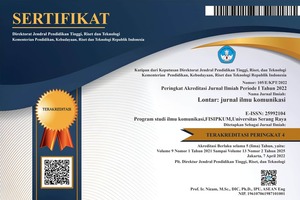Analisis Makna Pesan Simbolik Penyandang Oligodaktili Dusun Ulutaue di Kabupaten Bone
DOI:
https://doi.org/10.30656/lontar.v10i1.3693Keywords:
Bone, symbolic interaction, non-verbal communication, oligodactyly, UlutaueAbstract
ABSTRACT
People with oligodactyly are humans who have less than five fingers and toes. This deficiency is formed since their birth. This study involved five informants from Ulutaue Hamlet, Bone Regency of South Sulawesi Province, Indonesia. People with oligodactyly usually get the nicknames "crab man", "disgusting person", "mapakka finger". In addition to verbal forms, people with oligodactyly also receive non-verbal treatment. Hence, it makes them feel ashamed, heads down and offended. Behind those non-verbal ridicules, people with oligodactyly have non-verbal communication between each other to be used as defense or protection against strangers. Based on these conditions, this research entitled "Analysis of the Meaning of Symbolic Messages for Oligodactyly Persons in Ulutaue Village in Bone Regency". This type of research uses qualitative research methods, ethnographic studies of communication with the aim of describing, analyzing, and explaining the communication behavior of a group of people with oligodactyly.
The results of this research concluded that people with oligodactyly have special beliefs about "ade' tomatoa riolo" means the culture of the previous people have an effect on their survival. Departing from this understanding, the oligodactyly group believes that all of this cannot be separated from the existence of a great power that controls everything.
References
Cangara, H. (2018). Pengantar Ilmu Komunikasi. PT Raja Grafindo Persada.
Della, P. O. (2014). Penerapan Metode Komunikasi Non Verbal yang Dilakukan Guru pada Anak-Anak Autis di Yayasan Pelita Bunda Therapy Center Samarinda. Ejournal Ilmu Komunikasi, 2(4), 114–128.
Fitrah, A. N., Wahyuni, S., Idris, N., & Bahfiarti, T. (2018). Analysis of Symbolic Meaning of Shipping Technique and Navigation: Case Study of Sandeq Boat of the Mandar Tribe. 165, 316–320. https://doi.org/10.2991/iccsr-18.2018.70
Fitriyadewi, L. P. W., & Suarya, L. M. K. S. (2016). PERAN INTERAKSI SOSIAL TERHADAP KEPUASAN HIDUP LANJUT USIA Luh Putu Wiwin Fitriyadewi dan Luh Made Karisma Sukmayanti Suarya. Jurnal Psikologi Udayana, 3(2), 332–341. https://ojs.unud.ac.id/index.php/psikologi/article/download/25247/16455
Gumilang, G. S. (2016). Metode Penelitian Kualitatif dalam Bidang Bimbingan dan Konseling. Jurnal Fokus Konseling, 2(2), 144–159. http://ejournal.stkipmpringsewu-lpg.ac.id/index.php/fokus/a
Hikmawati, E., & Rusmiyati, C. (2011). Kebutuhan Pelayanan Sosial Penyandang Cacat. Sosio Informa, 16(01), 17–32.
Inah, E. N. (2015). PERAN KOMUNIKASI DALAM INTERAKSI GURU DAN SISWA Ety Nur Inah. Al-Ta’dib, 8(2), 150–167.
Kusumawati, T. I. (2016). Komunikasi Verbal Dan Nonverbal. Jurnal Pendidikan Dan Konseling, 6(2).
Maisarah, A., Nurani, F., Publik, A., Administrasi, F. I., & Brawijaya, U. (2019). Peran Kebudayaan Betawi sebagai Makhluk Sosial terhadap Peradaban Indonesia di Tengah Modernisasi dan Globalisasi. AP FIA UB.
Mulyana, D., & Sulaeman, . (2016). People with Lobster - Claw Syndrome: A Study of Oligodactyly Sufferers and their Communication Experiences in the Village of Ulutaue, South Sulawesi, Indonesia. Mediterranean Journal of Social Sciences, 7(1), 136–144. https://doi.org/10.5901/mjss.2016.v7n1s1p136
Nurdiani, N. (2014). Teknik Sampling Snowball dalam Penelitian Lapangan. ComTech: Computer, Mathematics and Engineering Applications, 5(2), 1110–1118. https://doi.org/10.21512/comtech.v5i2.2427
Purwasito, A. (2017). Analisis Pesan Message Analysis. The Messenger, 9(1), 103–109.
Sulaeman, & Putuhena, M. I. F. (2015). Pengalaman Komunikasi Penyandang Oligodaktili di Kampung Ulutaue , Bone, Sulawesi Selatan. Jurnal Dakwah, XVI(1), 117–138. https://doi.org/https://doi.org/10.14421/jd.2015.%25x
Sulaeman, S., & Mulyana, D. (2019). Makna Diri Penyandang Oligodaktili. Jurnal Penelitian Komunikasi, 22(1), 31–46. https://doi.org/10.20422/jpk.v22i1.595
Zakiah, K. (2008). Penelitian Etnografi Komunikasi: Tipe dan Metode. Mediator: Jurnal Komunikasi, 9(1), 181–188. https://doi.org/10.29313/mediator.v9i1.114
Downloads
Published
Issue
Section
License
By submitting an article to the journal, the author(s) agree to transfer the published article's copyright to the journal, which will act as the publisher. This means the journal will have the right to publish the article in various forms, including reprints. The journal will maintain the publishing rights to the published articles.
In line with the license, authors and third parties (readers, researchers, and others) are allowed to share and adapt the material. In addition, the material must be given appropriate credit, provided with a link to the license, and indicated if changes were made. If authors remix, transform, or build upon the material, authors must distribute their contributions under the same license as the original.






